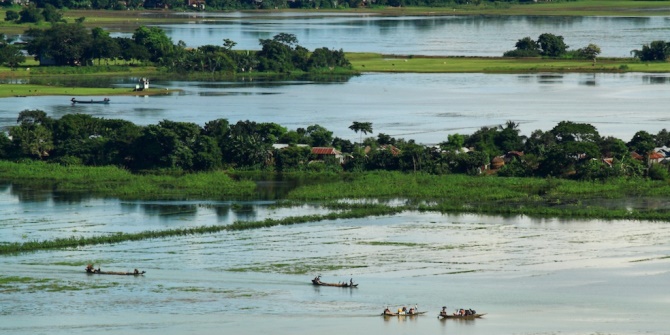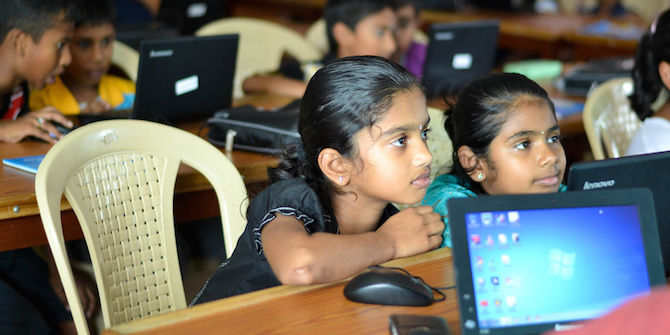 Within weeks of promulgating its first republican constitution Nepal has not just stepped into a new era domestically but also with its two giant neighbours, writes Shreya Paudel. India has imposed an “unofficial blockade”, leading to severe fuel shortages across the Himalayan nation and triggering strong anti-Indian sentiment. In response, Nepal has signed a breakthrough treaty with China, moving away from the turbulent trade marriage with its southern neighbour for the first time since 1950.
Within weeks of promulgating its first republican constitution Nepal has not just stepped into a new era domestically but also with its two giant neighbours, writes Shreya Paudel. India has imposed an “unofficial blockade”, leading to severe fuel shortages across the Himalayan nation and triggering strong anti-Indian sentiment. In response, Nepal has signed a breakthrough treaty with China, moving away from the turbulent trade marriage with its southern neighbour for the first time since 1950.
Nepal is currently being unofficially blockaded by India. Delhi on its part says that goods are not able to go towards Nepal because Madheshi protesters are blocking the passage, but traders have highlighted that goods are not even entering Nepal from the entry points like Kakarbhitta which have not been affected by Madheshi protesters. The few trucks that are crossing the border are not enough and the Nepalese are rapidly running out of gas and petrol, leading to fuel rationing and fears that supplies will run out completely. As a result, Nepal has signed a deal with the Chinese government to import emergency fuel. What is more, the Nepal Oil Corporation further stated that it plans to import at least one third of its fuel requirement from China in future. This marks a significant break in Nepal’s foreign policy which was previously bound by agreements with its southern neighbour which stipulated that India would supply all its fuel. So within weeks of promulgating its first republican constitution, Nepal has not just stepped into a new era domestically but also with its two giant neighbours.

Whose fault?
One of Nepal’s most prominent journalists, Kanak Mani Dixit tweeted on September 26, “If it feels, smells, looks, sounds and tastes like a blockade, then it is a BLOCKADE. Nothing left to hide, India! #indiablockadesnepal.” Prominent figures in India like Shashi Tharoor have also written to protest against the “de facto blockade”. At the end of October, people in Nepal spent their most important festival, Dashain / Dashera, struggling due to fuel shortages. Hospitals are losing their oxygen cylinders, industries have shut down and the post-earthquake humanitarian efforts are severely disrupted.
In October, the newly appointed Deputy Prime Minister and Foreign Minister of Nepal, Kamal Thapa, visited India in the hope of easing the trade flow between the two countries. There he met with the same repeated response from the Indian government officials: fix your own country, strike a deal with the protestors and the trade problems will slowly ease. But the reality seems to be that Delhi is reacting more broadly against Nepal’s new constitution. Just days before the promulgation of the constitution, India sent its foreign secretary to defer it. It wanted Nepal’s constitution to accommodate all the opposing political parties including the Madhesi parties. However, the major Nepali political parties went ahead anyway, citing that more than ninety per cent of elected Constituent Assembly (CA) members including those who were of Madhesi ethnicity, had agreed to the promulgation. This did not go well with the Indian government, which “noted” – rather than welcomed – the new constitution.
Although India may have ulterior motives for attributing the blockade to protestors, it is fair to say Nepal’s political leadership has not given due respect and the attention to Madhesi grievances, which primarily relate to the demarcation of the federal states. When more than 40 Madheshi protesters were killed by the police in the southern Nepal there was little reaction from Kathmandu. The protests are still seen by many major politicians as just another “fringe movement”, whereas it seems there is a genuine popular movement in at least some parts of Madhesh (southern Nepal) with thousands of people coming to the streets. So it may be true that the Nepali political leadership in Kathmandu must find a compromise with the Madeshis. However, this brings us to the question – why is Nepal so dependent on India in the first place?
The “Treaty of Peace and Friendship” between India and Nepal was signed in 1950. The then Indian Prime Minister, Jawaharlal Nehru, in his parliamentary speech had made it clear that this treaty was driven by security considerations of India. The subsequent treaties have tied Nepal and India in what now seems to be a difficult trade marriage. When there is a low point in that marriage, India has not shied away from temporarily blockading Nepal, as was seen in 1989 when a dispute over renewing lapsed trade pacts resulted in India cutting the majority of its trade links.
It is unlikely that Delhi is imposing the blockade because it feels a social responsibility in Madhesh, or fears for the safety of its tanker drivers. It does not take too long to understand that India like any other large neighbour has its own interests in Nepal. It might relate to the Bharatiya Janata Party’s desire to steer the election in Bihar, which has strong ethnic ties with southern Nepal. It might be linked to securing water deals with future federal governments in southern Nepal. For now, we can only speculate. However, what can be seen clearly is a significant foreign policy shift. Nepal’s newspapers nowadays are filled with commentaries reflecting on the understandable complex of being a smaller nation, tired of being “micro-managed” by its southern neighbour.
This public opinion coupled with possible future blockades have triggered a breakthrough treaty between China and Nepal. How far the Chinese petrol can splash Nepali roads is yet to be seen. However, this formal pact can be analysed as an unprecedented political statement from Nepal. Against Delhi’s own interests, its extreme measures are pushing Nepal towards seeing ties with China as preferable to complete dependence on India. Since 2014, China has become the largest foreign direct investor in Nepal, overtaking India. However, its interest in Nepal has not suddenly grown unexpectedly. China was always interested in Nepal, primarily to keep an eye on the large Tibetan refugee population in Nepal. Lately, it is only natural for the Chinese economic machine to attempt to spread its tentacles across to Nepal, an immediate neighbour, if it has reached as far as Africa and South America.
The way forward
The blockade has also heightened the ultra-nationalist anti-Indian sentiment in Nepal. This will be dangerous for both Nepal and India as the saying goes, “You can choose your friends but not your neighbours”. Nepal and India will need each other in future. The ‘people to people’ relationship between the two countries transgress the modern definitions of borders. As it is said, there is a ‘roti-beti’ (trade and marriage) relationship between the Nepalese and Indians both in the southern plains of Nepal as well as the bordering hills. It will be tragic to see the relationship weaken between the two peoples because of their governments’ inflexible policies.
To break this current impasse, the Indian government must resume trade immediately and the Nepali government take the Madhesi protesters seriously. As for Nepal’s relationship with China and India, the “equidistance approach” as officially advocated by Nepal needs to come into practice. It cannot lean predominantly, either to the south as it had done for so many decades or solely to the north as advocated by the anti-Indian sentiment.
Note: This article gives the views of the author, and not the position of the South Asia @ LSE blog, nor of the London School of Economics. Please read our comments policy before posting.
About the Author
 Shreya Paudel is a Chevening scholar with an interest in South Asian democratisation and development, currently studying for an MSc in Conflict Studies at LSE. Shreya was previously the elected International Students’ Officer at National Union of Students (UK) in 2014-2015. He tweets @shreya_paudel.
Shreya Paudel is a Chevening scholar with an interest in South Asian democratisation and development, currently studying for an MSc in Conflict Studies at LSE. Shreya was previously the elected International Students’ Officer at National Union of Students (UK) in 2014-2015. He tweets @shreya_paudel.







